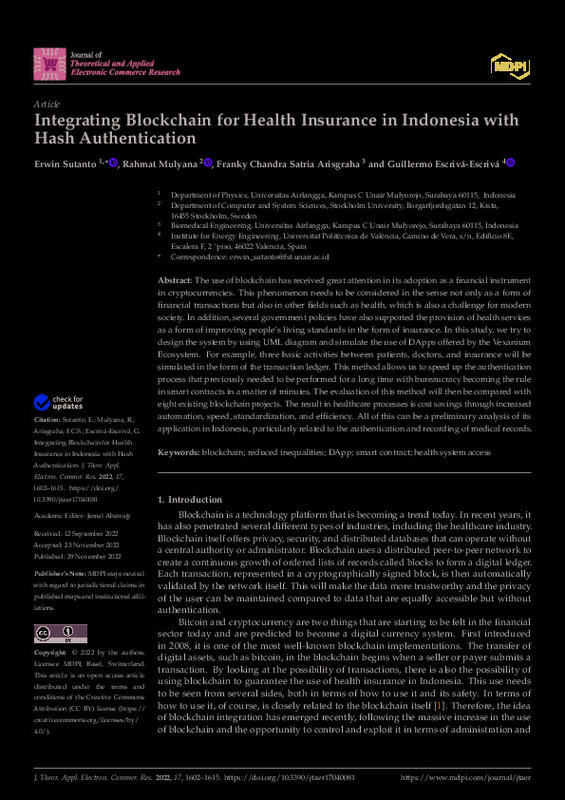JavaScript is disabled for your browser. Some features of this site may not work without it.
Buscar en RiuNet
Listar
Mi cuenta
Estadísticas
Ayuda RiuNet
Admin. UPV
Integrating Blockchain for Health Insurance in Indonesia with Hash Authentication
Mostrar el registro sencillo del ítem
Ficheros en el ítem
| dc.contributor.author | Sutanto, Erwin
|
es_ES |
| dc.contributor.author | Mulyana, Rahmat
|
es_ES |
| dc.contributor.author | Arisgraha, Franky Chandra Satria
|
es_ES |
| dc.contributor.author | Escrivá-Escrivá, Guillermo
|
es_ES |
| dc.date.accessioned | 2023-10-06T18:01:07Z | |
| dc.date.available | 2023-10-06T18:01:07Z | |
| dc.date.issued | 2022-12 | es_ES |
| dc.identifier.uri | http://hdl.handle.net/10251/197841 | |
| dc.description.abstract | [EN] The use of blockchain has received great attention in its adoption as a financial instrument in cryptocurrencies. This phenomenon needs to be considered in the sense not only as a form of financial transactions but also in other fields such as health, which is also a challenge for modern society. In addition, several government policies have also supported the provision of health services as a form of improving people's living standards in the form of insurance. In this study, we try to design the system by using UML diagram and simulate the use of DApps offered by the Vexanium Ecosystem. For example, three basic activities between patients, doctors, and insurance will be simulated in the form of the transaction ledger. This method allows us to speed up the authentication process that previously needed to be performed for a long time with bureaucracy becoming the rule in smart contracts in a matter of minutes. The evaluation of this method will then be compared with eight existing blockchain projects. The result in healthcare processes is cost savings through increased automation, speed, standardization, and efficiency. All of this can be a preliminary analysis of its application in Indonesia, particularly related to the authentication and recording of medical records. | es_ES |
| dc.description.sponsorship | This research was funded by Universitas Airlangga with grant number is 1421/UN3.1.8/PT/2022. | es_ES |
| dc.language | Inglés | es_ES |
| dc.publisher | MDPI AG | es_ES |
| dc.relation.ispartof | Journal of Theoretical and Applied Electronic Commerce Research | es_ES |
| dc.rights | Reconocimiento (by) | es_ES |
| dc.subject | Blockchain | es_ES |
| dc.subject | Reduced inequalities | es_ES |
| dc.subject | DApp | es_ES |
| dc.subject | Smart contract | es_ES |
| dc.subject | Health system access | es_ES |
| dc.subject.classification | INGENIERIA ELECTRICA | es_ES |
| dc.title | Integrating Blockchain for Health Insurance in Indonesia with Hash Authentication | es_ES |
| dc.type | Artículo | es_ES |
| dc.identifier.doi | 10.3390/jtaer17040081 | es_ES |
| dc.relation.projectID | info:eu-repo/grantAgreement/UNAIR//1421%2FUN3.1.8%2FPT%2F2022/ | es_ES |
| dc.rights.accessRights | Abierto | es_ES |
| dc.contributor.affiliation | Universitat Politècnica de València. Escuela Técnica Superior de Ingenieros Industriales - Escola Tècnica Superior d'Enginyers Industrials | es_ES |
| dc.description.bibliographicCitation | Sutanto, E.; Mulyana, R.; Arisgraha, FCS.; Escrivá-Escrivá, G. (2022). Integrating Blockchain for Health Insurance in Indonesia with Hash Authentication. Journal of Theoretical and Applied Electronic Commerce Research. 17(4):1602-1615. https://doi.org/10.3390/jtaer17040081 | es_ES |
| dc.description.accrualMethod | S | es_ES |
| dc.relation.publisherversion | https://doi.org/10.3390/jtaer17040081 | es_ES |
| dc.description.upvformatpinicio | 1602 | es_ES |
| dc.description.upvformatpfin | 1615 | es_ES |
| dc.type.version | info:eu-repo/semantics/publishedVersion | es_ES |
| dc.description.volume | 17 | es_ES |
| dc.description.issue | 4 | es_ES |
| dc.identifier.eissn | 0718-1876 | es_ES |
| dc.relation.pasarela | S\488076 | es_ES |
| dc.contributor.funder | Universitas Airlangga | es_ES |
| dc.subject.ods | 04.- Garantizar una educación de calidad inclusiva y equitativa, y promover las oportunidades de aprendizaje permanente para todos | es_ES |








